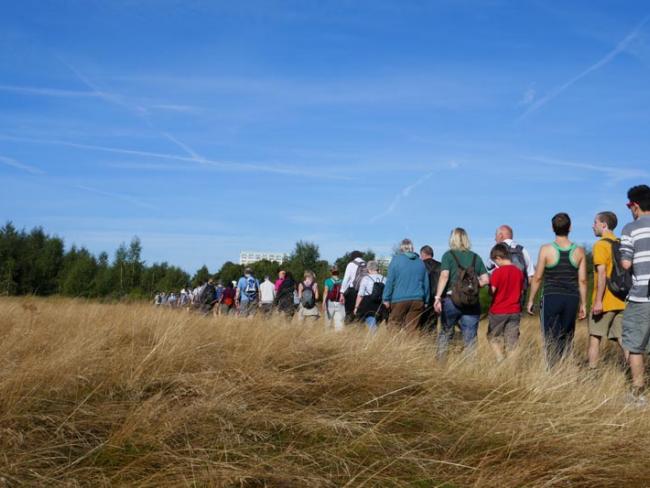
150 years on: Wanstead Flats, 2021 – a section of the annual walk celebrating the Epping Forest Act. Photo Workers.
Campaigns and direct action by workers in the 19th century saved Wanstead Flats on the edge of east London as an open space for the public…
Instead of being enclosed by landowners for massive housing developments, Wanstead Flats, a large flat grassland area of 344 acres which marked Epping Forest’s southern boundary, was saved by the people for the people.
Success here also stopped the whole of Epping Forest to the north suffering a similar fate. This impressive struggle involved a popular protest by thousands of ordinary Londoners.
The nearby residential population of Forest Gate played a key role in the struggle. Up to the 1870s Forest Gate was still a small west Essex village, on the edge of Wanstead Flats. Epping Forest, once part of a great stretch of woodland across the county, was reduced by this time to 6,000 acres located between Epping in the north and Forest Gate in the south.
Even this shrunken area of forest was under threat. The 19 Lords of the Manor, the forest landowners, began to see money could be made from enclosing and developing these vast open spaces on London’s doorstep. By the early 1870s, suburban development was spreading outwards, driven by the railway, which reached Forest Gate in 1846.
As houses covered more and more of London’s neighbouring countryside, voices of alarm were raised. Antonio Brady, a leading campaigner to save Epping Forest, called on “citizens of the East End, to protest against the encroachments on the forest, and to do battle with those who had filched from the people rights they had inherited from their ancestors.”
Such calls found a ready response among east Londoners, who on summer weekends and holidays came by train, “holiday van” or on foot, to enjoy the green space of the Forest. Wanstead Flats was a favourite destination.
The government was called on to legislate to stop the enclosure of London’s open spaces, and Epping Forest was the focus of attention. But Gladstone’s Liberal administration dragged its feet, to the frustration and anger of Londoners.
Matters came to a head in the summer of 1871, when Lord Cowley, the absentee landowner of Wanstead manor, instructed his agents to fence off Wanstead Flats, in preparation for clearance and house-building. Outrage erupted.
Mixed blessing
London’s unprecedented growth was a mixed blessing for Londoners. Although the new suburbs of outer London provided affordable housing for many workers, not just for more affluent residents, the expansion was also swallowing the green spaces which Londoners had for centuries enjoyed.
From the 1850s, the once-remote Epping Forest was under threat. Protest meetings were held not just locally but also in Hackney, Shoreditch, Stratford and elsewhere. A mass demonstration on Wanstead Flats was called for 8 July 1871.
A crowd estimated at 30,000 headed for the Flats. The more nervous organisers, fearful of the increasingly vocal calls for destruction of the fences, adjourned the demonstration to the grounds of nearby West Ham Hall.
But the demonstrators were having none of it. As soon as the first speaker began, there was a storm of hissing, and shouts of “to the Flats”. The whole demonstration shifted there.
‘This impressive struggle involved a popular protest by thousands of ordinary Londoners…’
The open-air meeting agreed to petition the Queen over the forest enclosures. Then the official leaders left, as did the large police detachment sent to guard the fences. Everything it seemed had passed off peacefully. But later that evening the mood changed.
A large section of the crowd began to demolish fences. The police, hastily recalled from Ilford, arrived to find much fencing reduced to matchwood. The police charged the crowd and arrested a Whitechapel cabinetmaker named Henry Rennie. A pitched battle then took place, as the crowd tried unsuccessfully to rescue him. He was later prosecuted, but only fined 5 shillings (25p), which was paid for him by one of the Forest Gate organisers.
National news
The demonstration attracted nationwide news coverage, much highly critical of the government. A few days later Prime Minister William Gladstone came to view the Flats. His administration then rushed through the first of a series of acts on Epping Forest, prohibiting further enclosures while a commission investigated.
But the campaign was just getting going. A pressure group, called the Forest Fund, was established in Forest Gate.
In 1872 the Forest Fund organised a second demonstration on Wanstead Flats, to coincide with another parliamentary debate on the future of Epping Forest.
By this time the City of London Corporation had entered the fray, using their rights as Epping Forest commoners to bring legal action against the Lords of the Manor in the forest to stop enclosures. The City was seizing an opportunity to win popular support among Londoners, who increasingly saw it as outdated, undemocratic and unaccountable.
Its championing of forest preservation did win the City Corporation much popular support, though many suspected its motives. The Corporation’s legal action, and parliamentary action by radical London MPs, led to the Epping Forest Act passed on 8 August 1878.
The first legal declaration in Britain of the right of the people to use an open space for leisure and enjoyment had implications not just for Epping Forest, but for other threatened spaces across Britain.
The defeat of the enclosures on Wanstead Flats was a watershed moment, still relevant today. Direct action and popular protests had prevented landowners enclosing land and excluding the public. The marvellous space of Wanstead Flats has been enjoyed for a further 150 years.
